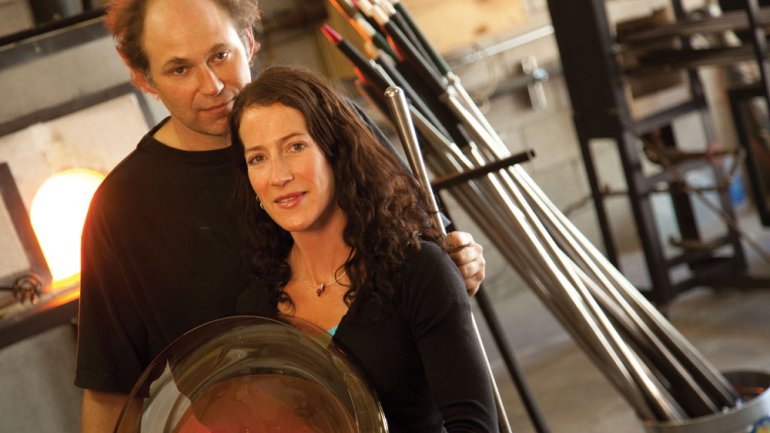A New Frontier
A New Frontier
Bengt Hokanson and Trefny Dix, buffeted by a tough economy, think they're in the right place now with their work.
Third street in Durango, Colorado, dead-ends at the base of a red rock mesa, dotted with piñon and sagebrush. A dirt trail winds its way up from the street. Mountain bikers jockey for the limited parking outside a nondescript, cinderblock warehouse, unaware that behind a weathered wooden door, Bengt Hokanson and Trefny Dix are transforming bulbs of honey-like molten glass into elaborate vessels of vivid color.
Hokanson and Dix are partners in life and work. They met in New Orleans in 1994 at Studio Inferno, where they demonstrated the art of glassblowing at the New Orleans jazz festival. Two years later, they opened their first glass studio in Greenport, New York, collaborating on a body of production work combining Italian and Swedish glassblowing techniques, under the name Boar Glass. They made bold pieces, with painterly abstract patterns and vibrant hues, inspired by the paintings of Howard Hodkins and Mark Rothko, African textiles, and colorful graffiti. They produced multiples of the same vessels - some tall and slender, others short, wide, and purse-shaped.
Boar Glass was a success by any measure. Hokanson and Dix ran a large retail gallery and hot shop while producing work for about 100 retail outlets, including Barneys in Manhattan. "But we were faced with having to expand and hire people to do it all well," Hokanson says. "The upside is you make more money. The downside is you have to deal with it."
Instead of expanding, the couple decided to focus on their wholesale business and find a new location with lower overhead costs. They moved their hot shop to a small town outside of Asheville, North Carolina, in 2007. Then came the economic crash in September 2008; their wholesale business contracted by three-quarters, and they were forced to close their studio and hot shop and take outside jobs.
Around that time, Hokanson's childhood friend, Spencer Compton, an avid mountain biker, invited the pair to visit him in Durango. As they talked during that trip, he suggested they relocate and even offered to invest in their business and help them set up their studio.
So in March 2010, they moved again, returning to the Greenport model with a hot shop, studio spaces, and a retail store.
But "it's not exactly unfolded that way," Dix says. "It's been challenging." They quickly realized the retail outlet was not going to work in a small town in southwestern Colorado, on a dusty street several blocks off Main Street, so they've established a relationship with Azul Gallery in Santa Fe.
"We've always had people come to us," Dix says. "Now we have to go out and find our customers."
In February, for the first time since 2008, they took their work to the American Craft Council show in Baltimore. The couple had successfully marketed Boar Glass at ACC shows since 2000, reaching wholesale clients through prepaid sales, meeting dealers directly, and building relationships. But this year, they found that things had changed. Fewer galleries were offering prepaid sales, instead shifting to consignment. And the galleries were interested in higher-end glass pieces, not the less expensive production multiples.
When they returned to Durango, they decided to focus on making more one-of-a-kind work, which makes sense both economically and creatively. "If we're going to be loaning work speculatively, I'd rather be doing more of what I really want to do," Hokanson says. "It's made us think about our work differently. One of the production pieces we used to make was a landscape bowl, and we decided to make a giant version." Dix interjects: "Once you get a functional thing like a bowl into a certain scale, then there's nothing a customer can think of to compare it to." The two talk in tandem, finishing thoughts and sentences. "People are more selective" in this economy, Dix continues. "They are looking for novelty, something that's unique."
After Baltimore, the couple also decided to revamp their website, which forced them to look at their work with fresh eyes, delineating production glass, art glass, and sculpture.
"We've always struggled with the fact that we had to do a production body of work," Dix says. Creating multiple glass vessels always seemed like their job, required to justify their fine art sculpture. And as is true in many jobs, there was plenty of repetition that wasn't artistically fulfilling. Now that they are focusing on one-of-a-kind pieces, they're free to let their individual interests shape their creations: Each work can be distinctive, its own aesthetic statement. Hokanson creates mixed-media works combining blown and cast glass with carved wood, fabricated metal and found objects. Dix prefers cast glass.
"We've started to do some glass where we didn't fully melt the glass in, and it retained a physical, structural integrity," Hokanson says. They have also started to integrate cast glass with photo imagery on the surface.
The couple like the shift in strategy. "Now that we've been able to focus on art glass, we feel re-energized, and it's starting to pay dividends for us," Dix says.
"We've had financial setbacks, but it's all going to work out. We've always found a way to keep it going. We've developed our life around being working artists."
Leanne Goebel is an award-winning writer, blogger, and journalist in southern Colorado.




